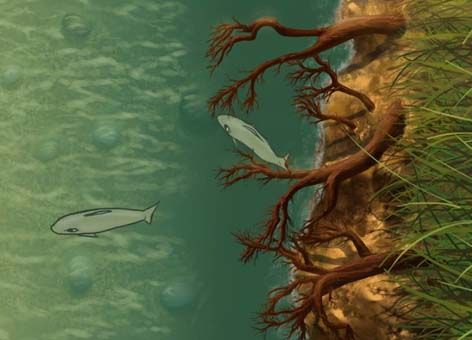Watch Art Explain What Kind of Habitat Young Salmon Need to Thrive
APRIL 21, 2014 -- What do young salmon need to grow into the kind of big, healthy adult salmon enjoyed by people as well as bears, seals, and other wildlife? A recent collaboration between NOAA Fisheries and the Pacific Northwest College of Arts makes the answer come to life in a beautiful animation by artists Beryl Allee and John Summerson. Watch the intersection of art and science as we follow young salmon happily swimming through the cool, shallow waters along a shore. We see the bits of wood, tangled tree roots, and scattered rocks that provide these fish with both insects to eat and protection from predators. But what happens when a home or business shows up along the water's edge? How do people remake the shoreline? What kind of environment does this create for those same little salmon? NOAA partnered with the Pacific Northwest College of Arts to create this moving and educational tool to raise awareness among waterfront landowners and the general public about how the decisions we make affect endangered salmon. In particular, NOAA wanted to address the practice of "armoring," or using physical structures such as rocks and concrete to protect shorelines from coastal erosion. As we can see in the animation, armored shorelines do not make for happy, healthy young salmon. However, alternatives to armoring shorelines with hard materials are emerging. They include using plants and organic materials to stabilize the shores while also preserving or creating the kind of habitat young salmon need. Creating better habitat for fish is often the goal of NOAA's Damage Assessment, Remediation, and Restoration Program (DARRP). When we determine that fish were harmed after an oil spill or hazardous chemical release, we, with the help of a range of partners and the public, identify and implement restoration projects to make up for this harm. Take a look at a few examples in which we built better habitat for salmon:
- Beaver Creek, Oregon: A tanker truck carrying gasoline overturned on scenic Highway 26 through central Oregon in 1999, spilling 5,000 gallons of gasoline into Beaver Butte Creek and impacting steelhead trout and Chinook salmon. Working with the Confederated Tribes of the Warm Springs Reservation of Oregon and other partners, we have helped implement five restoration projects. They range from adding large wood to stream banks to provide fish habitat to installing two beaver dam–mimicking structures to improve water quality.
- White River, Washington: In 2006 a system failure sent 18,000 gallons of diesel into creeks and wetlands important to endangered Chinook salmon around Washington's White River. To improve and expand habitat for these salmon, NOAA and our partners removed roadfill and added large pieces of wood ("logjams") along the edges of the nearby Greenwater River. This restoration project will help slow and redirect the river's straight, fast-moving currents, creating deep pools for salmon to feed and hide from predators and allowing some of the river water to overflow into slower, shallower tributaries perfect for spawning salmon.
- Adak, Alaska: On the remote island of Adak in Alaska's Aleutian Islands, a tanker overfilled an underground storage tank in 2010. This resulted in up to 142,800 gallons of diesel eventually flowing into the nearby salmon stream, Helmet Creek. Pink salmon and Dolly Varden trout were particularly affected. In 2013 NOAA and our partners restored fish passage to the creek, improved habitat and water quality, made stream flow and channel improvements, and removed at least a dozen 55-gallon drums from the creek bed and banks.
You can also watch a video to learn how NOAA is restoring recreationally and commercially important fish through a variety of projects in the northeast United States.
 An official website of the United States government.
An official website of the United States government. 
